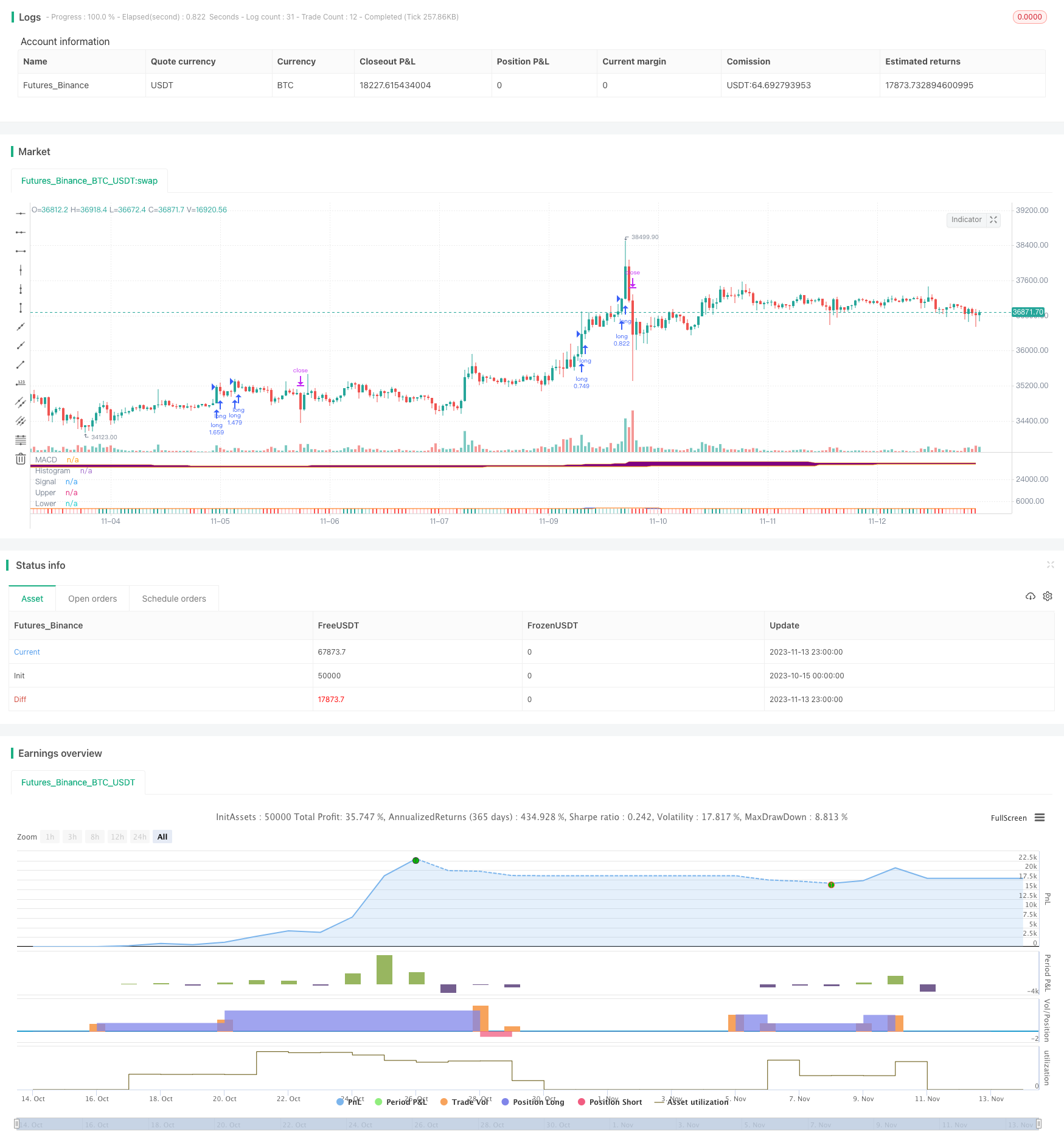MACD와 Donchian 채널의 트렌드를 따르는 전략
저자:차오장, 날짜: 2023-11-15 11:37:37태그:

전반적인 설명
이 전략은 트렌드를 결정하기 위해 돈치안 채널 지표와 MACD 지표를 결합합니다. 그것은 전형적인 트렌드 다음 전략에 속합니다. 가격이 상단 밴드를 깨고 MACD가 황금 십자가를 표시 할 때 길게 가고 가격이 하단 밴드를 깨고 MACD가 죽음의 십자가를 표시 할 때 짧게됩니다. ATR 지표는 스톱 손실을 계산하는 데 사용됩니다.
전략 논리
-
빠른 선, 느린 선 및 히스토그램을 포함한 MACD 지표를 계산합니다.
-
상부와 하부 돈치안 채널 대역을 계산합니다. 상부 대역은 N 일 동안 가장 높은 가격이고, 하부 대역은 N 일 동안 가장 낮은 가격입니다.
-
가격이 상단선을 넘어서고 MACD 빠른 라인이 느린 라인을 넘어서면,
-
가격이 하위 띠를 넘어서고 MACD 빠른 선이 느린 선 아래를 넘어가면
-
이 전략의 스톱 로스를 계산하기 위해 ATR 지표를 사용하십시오. 이 지수는 ATR 값과 현재 가격의 계수를 곱한 값으로 설정됩니다.
-
반전 신호가 나오면 위치를 닫아요
이점 분석
이 전략은 트렌드 판단 지표와 채널 지표를 결합하여 트렌드를 효과적으로 추적 할 수 있습니다. MACD 지표는 가격 추세와 동력을 판단합니다. 돈치안 채널은 방향을 판단합니다. ATR 스톱 로스는 거래 당 손실을 제한합니다.
이점:
-
전략은 간단하고 몇 가지 매개 변수만 있고 실행하기 쉽습니다.
-
트렌드를 따라 포지션을 개설하고, 트렌드 기회를 잡을 수 있습니다.
-
ATR 스톱 손실은 위험을 통제합니다.
-
마감량은 어느 정도 조절할 수 있습니다.
위험 분석
또한 몇 가지 위험이 있습니다.
-
돈치안 채널의 부적절한 파라미터 설정은 잘못된 신호를 일으킬 수 있습니다.
-
MACD 매개 변수 부적절한 경우 신호가 뒤떨어질 수도 있습니다.
-
너무 넓은 스톱 로스 설정은 확장 손실로 이어질 수 있습니다.
-
급격한 시장 변동은 엄청난 손실을 초래할 수 있습니다.
-
이 전략은 과잉 거래를 하는 경향이 있습니다.
해결책:
-
매개 변수를 최적화하고 주식을 신중하게 선택하세요.
-
엄격한 스톱 손실, 추후 스톱 손실.
-
위치 크기를 적절히 조정하세요.
최적화 방향
이 전략은 다음과 같은 측면에서 최적화 될 수 있습니다.
-
감수성을 높이기 위해 MACD 매개 변수를 최적화합니다.
-
스톱 로스 알고리즘을 최적화해서 가격에 가깝게 만들게
-
트렌드 강도에 따라 위치 사이즈 메커니즘을 추가합니다.
-
잘못된 신호를 피하기 위해 필터를 추가합니다.
-
거래용 상품의 선택 기준을 추가합니다.
-
거래 기간의 판단을 추가합니다.
요약
요약하자면, 이것은 전형적인 트렌드 다음 전략이다. 트렌드 방향을 나타내는 돈치안 채널과 트렌드 강도를 나타내는 MACD를 결합한다. 트렌드를 효과적으로 따라가며 위험을 제어할 수 있다. 매개 변수, 스톱 로스, 포지션 사이징 등을 최적화함으로써 안정성과 수익성이 더욱 향상될 수 있다. 이 전략은 트렌드 판단에 높은 정확성을 필요로 하는 투자자들에게 적합하다.
/*backtest
start: 2023-10-15 00:00:00
end: 2023-11-14 00:00:00
period: 1h
basePeriod: 15m
exchanges: [{"eid":"Futures_Binance","currency":"BTC_USDT"}]
*/
// This source code is subject to the terms of the Mozilla Public License 2.0 at https://mozilla.org/MPL/2.0/
// © Robrecht99
//@version=5
strategy("Trend Following with Donchian Channels and MACD", overlay=false, margin_long=100, margin_short=100, pyramiding=3)
// MACD //
fast_length = input(title="Fast Length", defval=12)
slow_length = input(title="Slow Length", defval=26)
src = input(title="Source", defval=close)
signal_length = input.int(title="Signal Smoothing", minval = 1, maxval = 50, defval = 9)
sma_source = input.string(title="Oscillator MA Type", defval="EMA", options=["SMA", "EMA"])
sma_signal = input.string(title="Signal Line MA Type", defval="EMA", options=["SMA", "EMA"])
col_macd = input(#2962FF, "MACD Line ", group="Color Settings", inline="MACD")
col_signal = input(#FF6D00, "Signal Line ", group="Color Settings", inline="Signal")
col_grow_above = input(#26A69A, "Above Grow", group="Histogram", inline="Above")
col_fall_above = input(#B2DFDB, "Fall", group="Histogram", inline="Above")
col_grow_below = input(#FFCDD2, "Below Grow", group="Histogram", inline="Below")
col_fall_below = input(#FF5252, "Fall", group="Histogram", inline="Below")
fast_ma = sma_source == "SMA" ? ta.sma(src, fast_length) : ta.ema(src, fast_length)
slow_ma = sma_source == "SMA" ? ta.sma(src, slow_length) : ta.ema(src, slow_length)
macd = fast_ma - slow_ma
signal = sma_signal == "SMA" ? ta.sma(macd, signal_length) : ta.ema(macd, signal_length)
hist = macd - signal
plot(hist, title="Histogram", style=plot.style_columns, color=(hist>=0 ? (hist[1] < hist ? col_grow_above : col_fall_above) : (hist[1] < hist ? col_grow_below : col_fall_below)))
plot(macd, title="MACD", color=col_macd)
plot(signal, title="Signal", color=col_signal)
// Donchian Channels //
Length1 = input.int(title="Length Upper Channel", defval=50, minval=1, group="Donchian Channels Inputs")
Length2 = input.int(title="Length Lower Channel", defval=50, minval=1, group="Donchian Channels Inputs")
h1 = ta.highest(high[1], Length1)
l1 = ta.lowest(low[1], Length2)
fillColor = input.color(color.new(color.purple, 95), title = "Fill Color", group = "Donchian Channels Inputs")
upperColor = input.color(color.new(color.orange, 0), title = " Color Upper Channel", group = "Donchian Channels Inputs", inline = "upper")
lowerColor = input.color(color.new(color.orange, 0), title = " Color Lower Channel", group = "Donchian Channels Inputs", inline = "lower")
u = plot(h1, "Upper", color=upperColor)
l = plot(l1, "Lower", color=upperColor)
fill(u, l, color=fillColor)
//ATR and Position Size //
strategy.initial_capital = 50000
length = input.int(title="ATR Period", defval=14, minval=1, group="ATR Inputs")
risk = input(title="Risk Per Trade", defval=0.01, group="ATR Inputs")
multiplier = input(title="ATR Multiplier", defval=2, group="ATR Inputs")
atr = ta.atr(length)
amount = (risk * strategy.initial_capital / (multiplier * atr))
// Buy and Sell Conditions //
entrycondition1 = ta.crossover(macd, signal)
entrycondition2 = macd > signal
entrycondition3 = macd and signal > hist
sellcondition1 = ta.crossover(signal, macd)
sellcondition2 = signal > macd
sellcondition3 = macd and signal < hist
// Buy and Sell Signals //
if (close > h1 and entrycondition2 and entrycondition3)
strategy.entry("long", strategy.long, qty=amount)
stoploss = close - atr * 4
strategy.exit("exit sl", stop=stoploss, trail_offset=stoploss)
if (sellcondition1 and sellcondition2 and sellcondition3)
strategy.close(id="long")
if (close < l1 and sellcondition2 and sellcondition3)
strategy.entry("short", strategy.short, qty=amount)
stoploss = close + atr * 4
strategy.exit("exit sl", stop=stoploss, trail_offset=stoploss)
if (entrycondition1 and entrycondition2 and entrycondition3)
strategy.close(id="short")
- 윌리엄스 프랙탈 쌍방향 거래 전략
- CT TTM 압축에 기반한 양적 거래 전략
- 오스실레이션 채널 브레이크업 전략
- 이동평균 및 MACD에 기초한 전략을 따르는 경향
- 이중 EMA 크로스오버 트렌드 ATR 및 ADX 필터와 전략에 따라
- 이중 이동 평균 스톱 손실 전략
- % 변경 바 차트 백테스트 전략
- 동력 역전 거래 전략
- 다중 지표 볼링거 밴드 거래 전략
- 기본 피너 거래 전략
- 트렌드 다음 전략 후속 스톱 손실과 거리를 기반으로
- ICHIMOKU 클라우드 및 STOCH 지표 기반 트렌드 추적 전략
- 모멘텀 브레이크업 전략
- 장점 이동 평균 브레이크 트렌드 추적 시스템
- 삼배 기하급수적 이동 평균 길게만 전략
- 3EMA와 스토카스틱 RSI 전략
- 이중 이동평균 트렌드 전략
- RSI 반전 거래 전략
- 시간 제한이 있는 이중 MA 전략
- 유동 평균과 슈퍼 트렌드에 기반한 트렌드 다음 전략